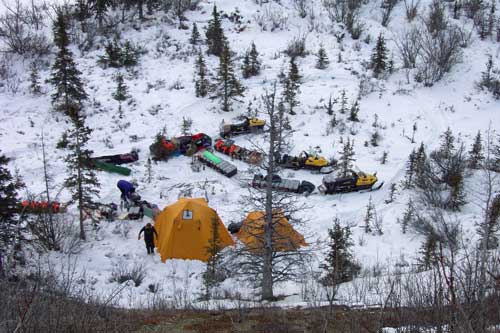 By Ned Rozell March 07, 2007
Matthew Sturm of the U.S. Army Cold Regions Research and Engineering Laboratory on Fort Wainwright is the leader of the trek across North America's Arctic.  Photo by Matthew Sturm.
The plan for a trip was born. Sturm, Holmgren, Glen Liston, Henry Huntington, and Dan Solie will begin their spring journey by riding from Fairbanks to Circle on the Yukon Quest trail. From Circle, they'll follow local trails to Fort Yukon, and then ride up the Porcupine River, cross the border into Canada, and visit the village of Old Crow. From there, they will traverse eastward, hitting settlements including Fort McPherson, Deline on Great Bear Lake, then to Kugluktuk on the south shore of the Arctic Ocean. From Kugluktuk, they will proceed southeast to Daring Lake. That leg of the journey is along a path of interest to northern history buffs. "We charted the route right on Franklin's starvation retreat," said Sturm, referring to British explorer John Franklin, who vanished in the Arctic in 1847. "Along the way, there's as much history as we could cram in." Since coming up with the idea for the trek, Sturm and his partners have immersed themselves in Franklin's diaries and other northern works, including "Barrenlands," in which author Kevin Krajick writes about the giant diamond mines in the area. "You're going through this remote area south of Kugluktuk and then all of a sudden the switch is flipped and you've got the diamond mines," Sturm said. "The goal of this thing is to see and experience the contradictory pieces of the Arctic." The University of Alaska Press is interested in publishing essays the travelers write about the Arctic, Sturm said. He hopes they will be able to capture some of the essence of the Arctic; he already knows the Alaska portion of the Arctic well, through similar snowmachine traverses he's done almost every year since 1994. Sturm and his partners will be riding Skandik SUVs, which he believes are the best work machines available. Each rider will be towing two large sleds with the equivalent of a 55-gallon drum of fuel in jugs on the back. They will camp in two Arctic Oven tents, and will also tow an equipment sled for the sampling they will do. They will bottle snow far from villages they will later test for soot content. They will also gather snow samples to test for mercury, and they'll also provide some ground-truthing to assist Canada scientists who want to calibrate satellite imagery of the area. The trip, sponsored by the National Science Foundation, will end about May 2 at the community of Baker Lake, just west of Hudson Bay, after the riders have put about 3,000 miles on their snowmachines. Along the way, they will visit about 20 schools. In each school, they will give presentations about what they are doing and the geography of the Far North. They may stay in some villages, but will probably camp outside the villages to avoid crowding the residents. "We tend to make quite a circus coming into town," Sturm said. Ned Rozell [nrozell@gi.alaska.edu] is a science writer at the institute. Publish A Letter on SitNews Read Letters/Opinions
|